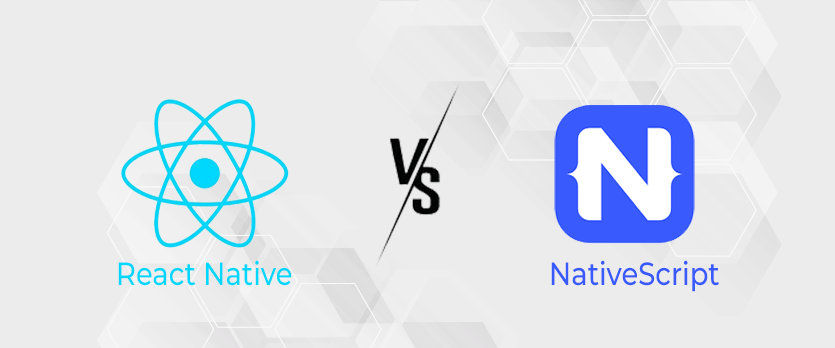The mobile industry is growing continuously, with new tech stacks being introduced every day with multiple framework options to choose from for your next project.
React Native vs NativeScript are both some of the popular JavaScript-based frameworks. But, which framework is best suitable for building complex applications? Or for developing apps that can extend on a niche-scale or enterprise-level? The list of questions and the criteria for choosing goes on. Choosing an unlikely framework that does not suit your project requirements might lead to paying through your nose.
To help you avoid such situations, we have conducted a comparative analysis to gather all the necessary and advanced details you need to know about React Native vs NativeScript in this article. By the end of this article, you will realize that all details are crucial.
React Native vs NativeScript – Pros and cons
Let’s compare React Native vs NativeScript to analyze their advantages and limitations.
Pros of React Native
Native rendering: Uses host platform to natively render APIs without the need for HTML or CSS markup.
Performance: Translates the markup of an application to mimic authentic UI elements and yet maintain high performance.
Ecosystem: Leverages rich ecosystem and UI libraries to automatically re-render app appearance with each state change.
Debugging: Provides accessibility to intelligent debugging tools and error reporting.
Hot-reloading: Allows hot reloading to add new codes directly into a live application.
Cons of React Native
User Interface: Native rendering of APIs may not support certain native UI elements, which may make the UI look a little off.
Tools and Plugins: Third-party libraries that can be used for better implementation may often turn out to be outdated.
Performance: Does not support parallel threading and multi-processing, resulting in slow performance.
Debugging: Chrome debugger might be inconvenient to edit, inspect codes, and UI elements properly.
Pros of NativeScript
Cross-technology compatibility: Uses Angular, TypeScript, or JavaScript that allows convenient data binding and more component reusability.
Native functionality: Accesses Native device API via native components developed with native performance.
Programming language: Uses an XML-Esque-based markup language like HTML to develop applications with customized features.
Extensibility: Gives complete and direct access to all kinds of iOS and Android APIs. This offers accessibility and allows for the reuse of free plugins, Android SDKs, and CocoaPods.
Developer-friendly CLI: NativeScript CLI allows developers to do almost anything ranging from adding a platform to deploying apps to a specific platform or device. Installation of plugins and app debugging is quicker and more comfortable.
Cons of NativeScript
UI limitation: DOM and HTML are not widely supported, which leaves the necessity to learn the use of different UI components. This eats up a good chunk of your time and budget.
Non-verified plugins: The total number of verified plugins are significantly less. Hence, there’s no assurance to the quality of plugins used in this framework.
Native Knowledge: Developers must be aware of the native functionality and APIs of iOS and Android. Only then can they access the hardware of a device and any other platform-specific elements.
Slower testing: Due to its native nature, an application can only accurately be tested on an emulator or an actual device. Consequently, this slows down the initial testing rate.
Performance comparison – React Native vs Nativescript
While performance should not be a killer factor for small projects, it becomes extremely important to consider it when building complex and large projects. With that being said, let’s compare React Native vs NativeScript in terms of performance.
In terms of performance, React Native has received quite a backlash from the development community. Under the hood, React Native comprises three elements: native thread, javascript thread, and a bridge that acts as a mediator to both threads. Whenever a user opens a React Native application, the native thread sends out a message to the javascript thread via the bridge. The number one reason why a few React Native applications have low performance is due to the fact that the number of messages that the javascript thread can process is limited. So when this limit is crossed, the UI starts to lag. In some cases, the application UI took longer than 16 milliseconds to render the program making the application stutter.
However, the good news is that the performance of a React Native application can be improved by doing some workarounds and using third-party libraries like Proguard that further optimizes bytecodes. Also, elements like Slowlog help setting performance timers that can help to track performance issues and to resolve them.
Application architecture – React Native and Nativescript
Under the hood, React Native possesses a bridge between the Native thread and JavaScript thread. As per this functionality, the JavaScript code communicates with the platform and the Native API. In iOS, React Native uses JavaScriptCore separately to run all codes, whereas it bundles the JavaScriptCore within the application in Android. Whilst this might increase the native functionality, it also increases the app size, resulting in performance issues or device lag.
Suitability for building complex apps – React Native vs Nativescript
Both React Native and NativeScript offer official documents, guidelines, open-source projects, third-party libraries, and plugins to support developers throughout the development process. Let’s compare how React Native vs NativeScript fare against each other in terms of building complex apps.
Yes, you can leverage React Native to build complex native apps. But it’s important to note that will be likely to be possible only when you involve native app development along with React Native. At that stage, your application is more likely to be hybrid than cross-platform. The entire process of building complex apps with React Native does not only involve Javascript but the utilization of native development skills.




